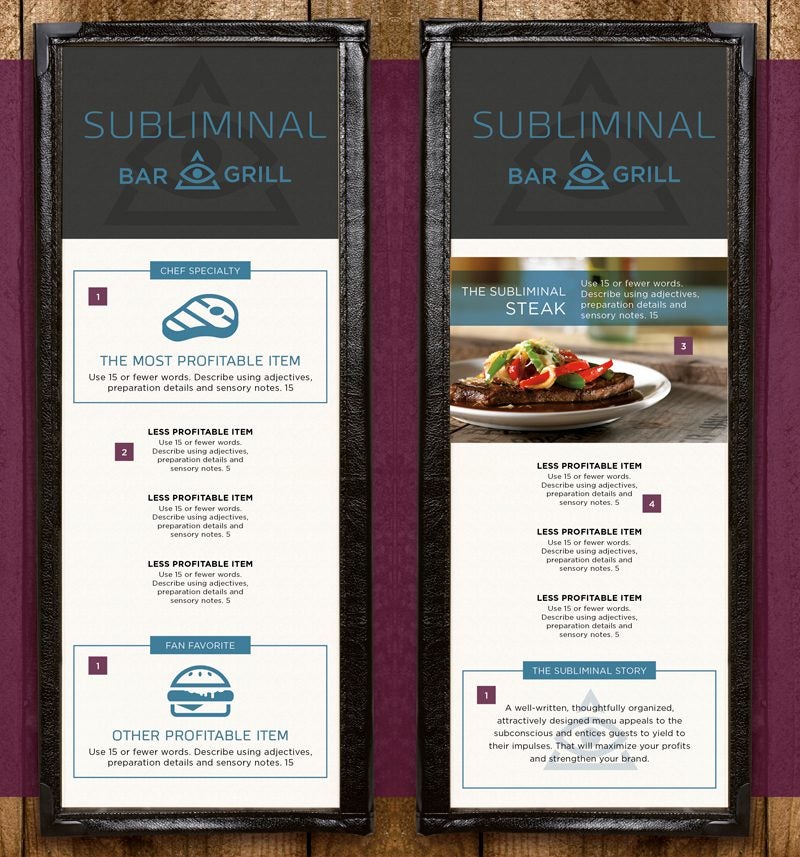Your menu is the only marketing tool 100 percent of your guests will see. That makes it an incredibly valuable and hardworking asset for your operation. A well-designed menu doesn’t just sell food; it also defines your brand and sets you apart in a crowded market.
Before physically designing (or redesigning) your menu, you need to establish goals for it, consider relevant trends and complete a full analysis of your existing menu (if applicable). Layer those in with these fundamentals and you’ll be well on your way to menu design success.
1) Steer the eyes
Customers scan menus rather than reading them front to back. The first and last items tend to draw more interest, so place your most profitable items there. People pay closer attention to the interior pages of multipage menus, so spotlight your stars inside. The back page of these menus is often overlooked, so—if you must use it—save it for breakfast or kids’ items, desserts or beverages.
Use color and graphics to draw further attention. Something as simple as a box around your star items can draw the eyes. Other effective approaches include shading names and descriptions of star items, and using icons or symbols to denote “specialties” or “old favorites.”
2) Choose your words carefully
Customers make ordering decisions based on the names and descriptions you provide. Regional and other descriptive adjectives add value and can boost sales dramatically. “Traditional Cajun red beans and rice” is likely to sell better than “red beans and rice.”
Preparation details like “mesquite-grilled” and sensory descriptors such as “fresh” and “tender” help paint a mouthwatering picture. Ingredient origins, signature flavors and exceptional portion sizes are worthy of highlighting. Today’s consumers—especially millennials—respond favorably to sustainability descriptors, so “local,” “organic,” “humane” and “no GMOs” are key buzzwords.
Stick to descriptions of 15 words at most (preferably less) to avoid overwhelming guests, and keep your menus short. Remember that today’s consumers are more sophisticated about foods and techniques, so you must be completely accurate with your descriptions.
3) Consider photos
Upscale restaurants tend to avoid photography on the menu, but a few photos can be a sales-boosting addition to more casual menus. Use them sparingly; one large photo per category is better than a small photo accompanying each dish. Colorful, high-quality shots are a must. It’s imperative that the dish delivered to the table looks like the dish in the photograph.
4) Hide your prices
You want customers to focus on your food, not your prices. Don’t call attention to prices with dollar signs or other currency symbols. Don’t place them in a column down the right side of your menu; that invites price shopping. Instead, place the price inconspicuously at the end of each item description, in the same font and size.
Round prices up to the nearest quarter for items under $5; $2.15 should become $2.25, for example. For items above $5, round prices up in increments of up to 50 cents—so $10.60 would become $10.99. Always respect the 99-cent rule: $10.99 will be perceived as a better value than $11.00.
Protect your brand
Your menu must communicate your brand. Ask someone who’s never been to your restaurant to describe it based solely on your physical menu. If their description is way off, your menu may be way off as well.
A well-written, thoughtfully organized, attractively designed menu appeals to the subconscious and entices people to yield to their impulses. And that will maximize your profits and strengthen your brand.




























